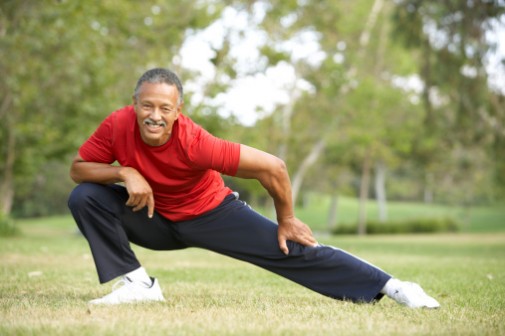Fitness for baby boomers not one-size-fits-all

You may have heard that age 30 is the new 20, 40 is the new 30, and so on. Though it’s a bit cliché, the saying seems to reflect a major shift in our society — more Americans are living longer.
According to the U.S. Census, about 40 million people in the United States — 13 percent of the population — are 65 or older.
Gloria Mrazek, NSCA-CPT, personal trainer at the Advocate Good Samaritan Health and Wellness Center in Downers Grove, Ill. says aging gracefully can mean more challenges in designing the right fitness routine.
“Fitness goals run the gamut for seniors,” she says. “Some are training for triathlons, while others want to improve their quality of life.”
Mrazek says it’s important that seniors recognize that their goals should change as their bodies do and consult with their doctors before starting any exercise routine.
“I think people over 65 should keep in mind how important exercise can be for preventing chronic conditions as well as maintaining bone and muscle strength,” she says.
Why is managing chronic conditions important?
Research shows exercise can significantly help reduce the risks of heart disease, stroke and diabetes.
Mrazek says this is why cardiovascular exercise can be a huge benefit. “The goal is to exercise within the target heart rate that is based on your age,” she says.
Cardio exercise has also been shown to help reverse plaque buildup in the arteries that can lead to heart disease complications and stroke. It can also lower your blood sugar level and improve your body’s ability to produce insulin, a hormone that regulates blood sugar, according to the National Institute of Diabetes and Digestive and Kidney Diseases.
Mrazek says some examples of good cardio exercise routines for seniors include brisk walking, jogging or dancing.
How do you maintain bone and muscle strength?
According to the U.S. Centers for Disease Control and Prevention, one out of three adults over age 65 will suffer a fall this year. Falls are among the top reasons older adults are admitted to the hospital, and they cause serious head trauma, fractures or even death.
Preventing falls start with using your muscles and bones to help maintain balance and agility.
“As we age, our bone density decreases, making bones weaker and more prone to fracture if we fall,” says Mrazek. “ At the same time if strength training isn’t added to an exercise routine muscles will atrophy.”
That’s why the likelihood of falls increases four to five times between ages 65 and 75.
Mrazek says strength training routines for older adults should include weight lifting, along with exercises that improve balance and flexibility, which helps muscles maintain a full range of motion instead of becoming stiff.
Getting started, sticking with it
“One of the things we’re noticing is that this generation of older adults was not raised to exercise [outside of playing sports],” Mrazek says. That means older adults with exercise routines and fitness goals signal a cultural shift in senior lifestyle habits.
And with strong research continuing to link good health to exercise, nailing down the right fitness routine as you age could be the secret to turning 60 into the new 40.
Before you get started Mrazek offers these four key steps to help you on your journey to better health:
- Get your physician’s approval and a physical assessment — The physician’s approval will consider all of your conditions, physical limitations and medications to make sure the fitness routine is appropriate and won’t cause an injury. This is particularly important for people with diabetes, osteoporosis and heart conditions.
- Stay consistent — This is important for everyone, but it’s especially important for older adults who struggle with memory loss. “If you only do balance and flexibility exercises once a week and strength training once a week, then don’t exercise again for another two weeks, it’s going to be hard to see progress,” says Mrazek.
- Get a partner — It could be a friend or a personal trainer. “If you arrange to work out with a friend or a personal trainer you are more apt to exercise regularly because you will have the support and motivation from that person.”
- Don’t let soreness or fatigue stop you — Mrazek says a little soreness is okay, as long as you’re not in a situation where you’re in pain. Ironically, one of the best cures for fatigue is exercise.“You just have to get moving.”
Related Posts
Comments
About the Author
health enews staff is a group of experienced writers from our Advocate Health Care and Aurora Health Care sites, which also includes freelance or intern writers.

















